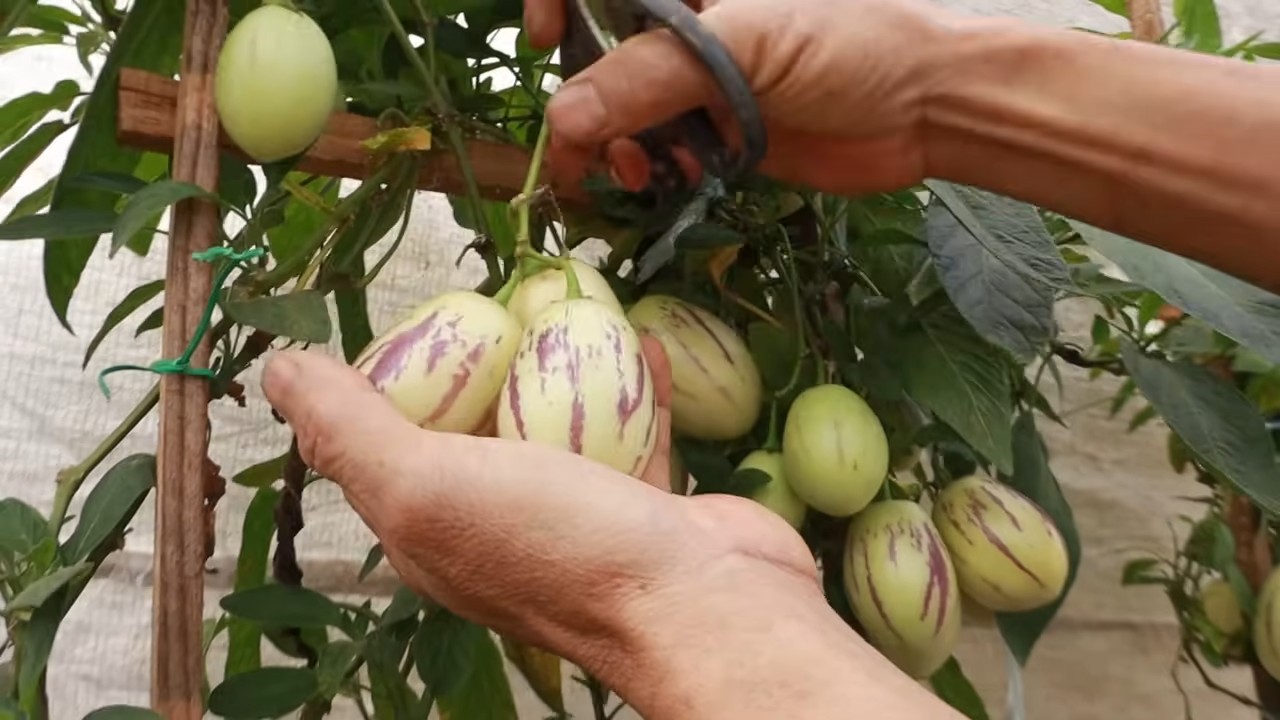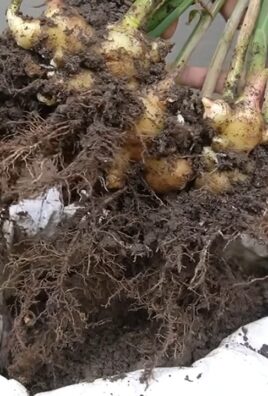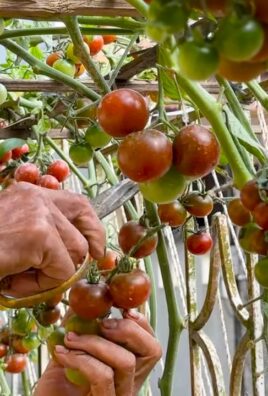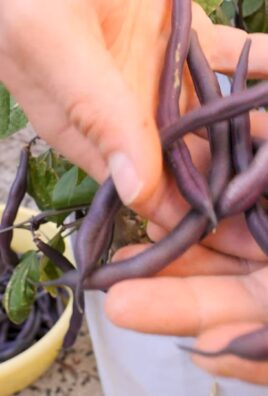Grow Pepino Melon at Home and unlock a world of sweet, juicy goodness right in your backyard! Have you ever dreamed of biting into a refreshingly unique fruit that tastes like a cross between a cantaloupe and a cucumber? Well, dream no more! This DIY guide will empower you to cultivate your very own Pepino Melon paradise, even if you’re a complete beginner.
While not as widely known as its melon cousins, the Pepino Melon boasts a fascinating history, originating in the Andean regions of South America. For centuries, indigenous communities have cherished this fruit for its delicious flavor and nutritional benefits. Now, you can bring a piece of that heritage to your own garden!
Why should you embark on this exciting gardening adventure? Because store-bought Pepino Melons can be hard to find and often lack the vibrant flavor of homegrown varieties. Plus, growing Pepino Melon at home is incredibly rewarding! Imagine the satisfaction of harvesting your own fresh, organic fruit, knowing exactly where it came from and how it was grown. This DIY project is not only fun and educational, but it also provides you with a sustainable source of deliciousness. Let’s get started and transform your garden into a Pepino Melon haven!

Growing Pepino Melon: A Sweet and Simple DIY Guide
Hey there, fellow gardening enthusiasts! Ever heard of the Pepino Melon? It’s a fascinating fruit that tastes like a cross between a cantaloupe and a cucumber, and guess what? You can totally grow it at home! I’ve had a blast cultivating these unique melons, and I’m excited to share my experience with you. This guide will walk you through every step, from starting seeds to harvesting your own delicious Pepino Melons. Let’s get started!
Choosing Your Pepino Melon Variety
Before we dive into the nitty-gritty, let’s talk varieties. While there aren’t a ton of commercially available Pepino Melon cultivars, you’ll likely find a few options. Here’s what I’ve learned:
* ‘El Camino’: This is a popular choice, known for its good flavor and relatively early maturity. It produces medium-sized fruits with a yellow skin and purple stripes.
* ‘Gold Nugget’: As the name suggests, this variety yields golden-yellow fruits. It’s often praised for its sweetness.
* ‘Rio Bamba’: This one is a bit less common, but worth seeking out if you can find it. It’s known for its larger fruit size and excellent flavor.
I recommend doing a little research to see what’s available in your area and choosing a variety that suits your taste and climate.
Starting Pepino Melon Seeds (or Cuttings!)
Pepino Melons can be grown from seeds or cuttings. I’ve had success with both methods, but starting from seeds requires a bit more patience.
Starting from Seeds:
1. Gather Your Supplies: You’ll need Pepino Melon seeds, seed starting trays or small pots, seed starting mix (a light, well-draining mix is crucial), a spray bottle, and a heat mat (optional, but helpful).
2. Sow the Seeds: Fill your seed starting trays or pots with the seed starting mix. Moisten the mix thoroughly with the spray bottle. Sow the seeds about ¼ inch deep, placing 2-3 seeds per cell or pot.
3. Provide Warmth and Moisture: Pepino Melon seeds need warmth to germinate. Place the trays or pots on a heat mat if you have one. Cover them with a clear plastic dome or plastic wrap to create a humid environment. Mist the soil regularly to keep it moist but not soggy.
4. Wait for Germination: Germination typically takes 1-3 weeks, depending on the temperature. Once the seedlings emerge, remove the plastic cover and place them under a grow light or in a sunny window.
5. Thin the Seedlings: Once the seedlings have developed a few true leaves, thin them to one seedling per cell or pot. Choose the strongest, healthiest seedling and snip off the others at the soil line.
Starting from Cuttings:
This is a faster way to get Pepino Melon plants!
1. Take Cuttings: In late spring or early summer, take 4-6 inch cuttings from healthy, non-flowering stems. Remove the lower leaves, leaving only a few leaves at the top.
2. Rooting Hormone (Optional): Dip the cut end of each cutting in rooting hormone powder. This will help promote root development.
3. Plant the Cuttings: Insert the cuttings into small pots filled with well-draining potting mix.
4. Create a Humid Environment: Cover the pots with a clear plastic bag or dome to create a humid environment.
5. Wait for Roots to Develop: Place the cuttings in a warm, bright location (but out of direct sunlight). Keep the soil moist but not soggy. Roots should develop in 2-4 weeks. You’ll know they’ve rooted when you see new growth.
Transplanting Your Pepino Melon Seedlings or Cuttings
Once your seedlings or cuttings have developed a strong root system, it’s time to transplant them into larger pots or directly into your garden.
1. Harden Off the Plants: Before transplanting, you’ll need to “harden off” the plants. This means gradually acclimating them to outdoor conditions. Start by placing them outside for a few hours each day, gradually increasing the amount of time they spend outdoors over the course of a week.
2. Choose a Sunny Location: Pepino Melons need at least 6-8 hours of sunlight per day. Choose a location in your garden that receives plenty of sun.
3. Prepare the Soil: Pepino Melons prefer well-draining soil that is rich in organic matter. Amend your soil with compost or well-rotted manure before planting.
4. Transplant the Plants: Dig a hole that is slightly larger than the root ball of the plant. Gently remove the plant from its pot and place it in the hole. Backfill with soil and water thoroughly. Space plants about 2-3 feet apart.
Caring for Your Pepino Melon Plants
Now that your Pepino Melon plants are in the ground, it’s time to provide them with the care they need to thrive.
1. Watering: Water your Pepino Melon plants regularly, especially during hot, dry weather. Aim to keep the soil consistently moist but not waterlogged.
2. Fertilizing: Fertilize your Pepino Melon plants every 2-3 weeks with a balanced fertilizer. I like to use a liquid fertilizer diluted to half strength.
3. Pruning: Pepino Melon plants can become quite bushy, so pruning is important to improve air circulation and encourage fruit production. Remove any suckers (shoots that grow from the base of the plant) and prune back any overly crowded branches.
4. Support: Pepino Melon plants can benefit from support, especially when they are laden with fruit. You can use stakes, trellises, or cages to support the plants.
5. Pest and Disease Control: Keep an eye out for pests such as aphids, whiteflies, and spider mites. Treat infestations promptly with insecticidal soap or neem oil. Pepino Melons are also susceptible to fungal diseases such as powdery mildew. Prevent fungal diseases by providing good air circulation and avoiding overhead watering. If you notice signs of fungal disease, treat with a fungicide.
Pollination: Helping Your Pepino Melons Set Fruit
Pepino Melons are self-pollinating, meaning they don’t require insects to transfer pollen. However, sometimes they need a little help, especially in hot or humid weather.
1. Hand Pollination: If you’re not seeing fruit set, you can try hand-pollinating the flowers. Use a small paintbrush to transfer pollen from the male flowers (those with a thin stem) to the female flowers (those with a small fruit behind the flower).
2. Encourage Pollinators: Even though Pepino Melons are self-pollinating, attracting pollinators to your garden can still be beneficial. Plant flowers that attract bees and other pollinators near your Pepino Melon plants.
Harvesting Your Pepino Melons
The moment we’ve all been waiting for! Harvesting your own homegrown Pepino Melons is incredibly rewarding.
1. When to Harvest: Pepino Melons are ready to harvest when they turn a pale yellow or cream color and develop purple stripes. The fruit should also feel slightly soft to the touch.
2. How to Harvest: Gently twist or cut the fruit from the vine.
3. Storage: Pepino Melons can be stored in the refrigerator for up to a week.
Enjoying Your Pepino Melons
Now for the best part – eating your Pepino Melons! They can be eaten fresh, added to salads, or used in desserts. I personally love them chilled, sliced, and enjoyed as a refreshing snack. You can also blend them into smoothies or use them to make salsa. The possibilities are endless!
Troubleshooting: Common Pepino Melon Problems
Even with the best care, you might encounter a few challenges along the way. Here are some common problems and how to address them:
* Lack of Fruit Set: This can be caused by poor pollination, hot weather, or nutrient deficiencies. Try hand-pollinating the flowers, providing shade during the hottest part of the day, and fertilizing with a balanced fertilizer.
* Yellowing Leaves: This can be a sign of overwatering, underwatering, or nutrient deficiencies. Check the soil moisture and adjust your watering accordingly. Fertilize with a balanced fertilizer.
* Pest Infestations: Treat pest infestations promptly with insecticidal soap or neem oil.
* Fungal Diseases: Prevent fungal diseases by providing good air circulation and avoiding overhead watering. If you notice signs of fungal disease, treat with a fungicide.
Final Thoughts
Growing Pepino Melons at home is a fun and rewarding experience. With a little patience and care, you can enjoy these unique and delicious fruits from your own garden. Don’t be afraid to experiment and try different techniques to find what works best for you. Happy gardening!

Conclusion
So, there you have it! Growing Pepino Melon at home isn’t just a gardening project; it’s an adventure in flavor and a testament to the joys of cultivating your own food. We’ve walked you through the process, from selecting the right seeds or cuttings to nurturing your plant and harvesting those uniquely delicious fruits.
Why is this DIY trick a must-try? Because it empowers you to enjoy a fruit that’s often difficult to find in stores, and when you do find it, it’s often expensive and lacking the vibrant flavor of a homegrown Pepino Melon. You’re not just growing a fruit; you’re growing an experience. You’re connecting with nature, learning about plant life, and ultimately, savoring the fruits (literally!) of your labor. Plus, imagine the bragging rights when you serve a dish featuring Pepino Melon that you grew yourself!
But the journey doesn’t end here. Feel free to experiment with different growing techniques. Try different soil mixes to see what works best in your climate. Consider using companion planting to deter pests and attract beneficial insects. You can even try growing your Pepino Melon in a container, making it perfect for balconies or patios.
Variations and Suggestions:
* Vertical Gardening: Pepino Melon vines can be trained to grow vertically, saving space and adding a beautiful green element to your garden. Use trellises or stakes to support the vines.
* Grafting: For faster fruit production and increased disease resistance, consider grafting your Pepino Melon onto a hardier rootstock, such as eggplant.
* Flavor Infusions: Experiment with different fertilizers and soil amendments to influence the flavor of your Pepino Melon. Some gardeners swear by adding a touch of Epsom salts to the soil for sweeter fruits.
* Preserving Your Harvest: Don’t let any Pepino Melon go to waste! You can pickle them, make them into jams or preserves, or even dehydrate them for a sweet and chewy snack.
* Creative Culinary Uses: Beyond eating them fresh, incorporate Pepino Melons into salads, salsas, smoothies, or even grilled dishes. Their unique flavor pairs well with both sweet and savory ingredients.
We wholeheartedly encourage you to embark on this rewarding gardening endeavor. Growing Pepino Melon at home is a fantastic way to connect with nature, enjoy fresh, delicious produce, and impress your friends and family.
Don’t be afraid to get your hands dirty, experiment, and learn from your experiences. Every garden is unique, and what works for one person may not work for another. The key is to be patient, observant, and adaptable.
And most importantly, we want to hear about your journey! Share your experiences, tips, and photos with us. Let us know what challenges you faced, what successes you celebrated, and what delicious dishes you created with your homegrown Pepino Melons. Your insights can help other aspiring gardeners and inspire even more people to try this amazing DIY trick. So, grab your seeds or cuttings, prepare your soil, and get ready to experience the joy of growing your own Pepino Melon! Happy gardening!
Frequently Asked Questions (FAQ)
What exactly is a Pepino Melon and what does it taste like?
The Pepino Melon (Solanum muricatum) is a fruit native to South America. It’s known for its unique flavor, which is often described as a combination of melon, cucumber, and pear. The taste can vary depending on the ripeness and variety, but generally, it’s sweet, refreshing, and slightly tangy. The texture is similar to a melon, with a juicy and slightly crisp flesh.
Is it difficult to grow Pepino Melon at home?
No, it’s not particularly difficult, but it does require some attention and care. Pepino Melons thrive in warm climates with plenty of sunlight and well-drained soil. They are relatively easy to propagate from cuttings, which can make the process even simpler. The key is to provide them with consistent moisture, adequate support, and protection from frost. With a little patience and effort, you can successfully grow Pepino Melons at home.
What kind of soil is best for growing Pepino Melon?
Pepino Melons prefer well-drained, fertile soil with a slightly acidic to neutral pH (around 6.0 to 7.0). A good soil mix would include a combination of garden soil, compost, and perlite or vermiculite to improve drainage. You can also add some slow-release fertilizer to provide essential nutrients. Avoid heavy clay soils, as they can retain too much moisture and lead to root rot.
How much sunlight does a Pepino Melon plant need?
Pepino Melons need at least 6-8 hours of direct sunlight per day to thrive. Choose a sunny location in your garden or on your balcony where the plant will receive ample sunlight. If you’re growing them indoors, you may need to supplement with grow lights, especially during the winter months. Insufficient sunlight can result in leggy growth, reduced fruit production, and less flavorful fruits.
How often should I water my Pepino Melon plant?
Water your Pepino Melon plant regularly, especially during hot and dry weather. The soil should be kept consistently moist, but not waterlogged. Check the soil moisture level regularly by sticking your finger into the soil. If the top inch feels dry, it’s time to water. Avoid overwatering, as this can lead to root rot. During the cooler months, you can reduce the watering frequency.
Are Pepino Melons susceptible to any pests or diseases?
Yes, Pepino Melons can be susceptible to certain pests and diseases, such as aphids, spider mites, whiteflies, and powdery mildew. Regularly inspect your plants for any signs of infestation or disease. You can control pests with insecticidal soap or neem oil. To prevent powdery mildew, ensure good air circulation around the plants and avoid overhead watering.
When is the best time to harvest Pepino Melons?
Pepino Melons are typically ready to harvest about 60-80 days after planting. The fruits will change color from green to a creamy yellow or pale orange, depending on the variety. They should also feel slightly soft to the touch. The aroma will also become more pronounced as they ripen. Harvest them gently by clipping the stem with pruning shears.
Can I grow Pepino Melon in a container?
Yes, you can successfully grow Pepino Melon in a container, making it a great option for those with limited space. Choose a large container (at least 15-20 gallons) with good drainage holes. Use a well-draining potting mix and provide the plant with adequate support, such as a trellis or stake. Container-grown Pepino Melons may require more frequent watering and fertilization than those grown in the ground.
How do I propagate Pepino Melon from cuttings?
Propagating Pepino Melon from cuttings is a relatively easy process. Take a 4-6 inch cutting from a healthy stem, removing the lower leaves. Dip the cut end in rooting hormone and plant it in a pot filled with moist potting mix. Cover the pot with a plastic bag or dome to create a humid environment. Keep the soil moist and place the pot in a warm, bright location. Roots should develop within a few weeks. Once the cutting has established roots, you can transplant it into a larger pot or into the garden.
Are there different varieties of Pepino Melon?
Yes, there are several varieties of Pepino Melon, each with slightly different characteristics in terms of size, shape, color, and flavor. Some popular varieties include ‘El Tigre’, ‘Gold Star’, and ‘Sweet Long’. Experiment with different varieties to find the one that you enjoy the most. You may need to source seeds or cuttings from specialty nurseries or online suppliers.




Leave a Comment